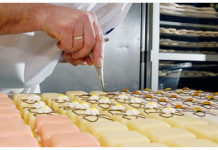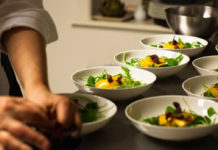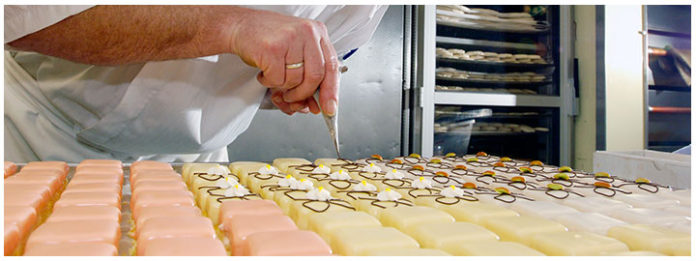Ballpark estimate: $13,000 to $200,000 (depending on the level of training you select)
Most people find the fancy, sweet creations of modern pastry chefs hard to resist. Whether it’s the quintessential cream puff or a slice of freshly-made cheesecake topped with raspberry Chambord sauce or a chocolate mousse cake garnished with freshly shaved dark chocolate ribbons, everyone has a favorite dessert. In fact, once you step inside a fine French bakery, it’s hard to resist the powerful aroma of pastry that fills the nostrils with delight and alerts the taste buds that a special treat is on the way.
History of the Pastry Chef
Technically, pastry is a dough made from flour, shortening, and water. The first references to pastry came in ancient Mediterranean cuisines including the Greek, Roman, and Phoenician societies. Today’s pastry chefs learn to create a variety of different types of desserts—from the decadently rich French custard topped with caramel known as Crème Brulèe to the Greek puff pastry topped with honey and chopped nuts called Baklava. While the French are well known for their wide variety of deserts and pastries, many cultures enjoy their own wonderful sweet traditions. The modern dessert menu draws on many different styles to include a staggering array of delicious confections.
Training Programs and Schools
If you’re passionate about working in a kitchen and can handle the long hours and rigorous attention to detail, you may find training and working as a pastry chef very rewarding. Excellent pastry chef training programs are available in major cities across the United States, including New York, Chicago, San Francisco, and Los Angeles. Many schools are internationally acclaimed such as the Culinary Institute of America (CIA) in New York, the International Culinary Center in Silicon Valley, and Johnson & Wales University in Providence, Rhode Island. These desirable schools offer short-term training programs, as well as an Associate’s Degree and/or a Bachelor’s Degree option.
Many students choose one of the short term, intense training programs that focus on hands-on coursework in the pastry kitchen. These programs usually run either six or nine months long (depending on the number of training hours per week). If you’re interested in spending all morning or afternoon in the kitchen, you can finish a program in just six months and be ready to start looking for a job. But if you’re working a job or caring for a family at the same time you’re participating in the training curriculum, then you may prefer the slower pace of an evening program. This option will probably take nine months to earn the certificate.
Sample Curriculum
Most of the curriculums for the short-term, intense programs take place in the kitchen, where you will learn a variety of techniques. For instance, if you attend ICC, the types of things you’ll learn during a six-month course include:
- A range of professional techniques, from fundamentals to complex
- Working with chocolate to create showpieces
- Creating sugar paste flowers and decorations
- Professional-quality cake baking and decorating
- Calculating costs and portion yields
Other schools will offer similar coursework including such specific skills as bread making, breakfast pastries, cakes and tarts, frozen desserts, puff pastries, chocolate artistry, custards and mousses, sugar work cookies, piping and decorations, plated desserts, and other specialized techniques to make creative desserts in a modern pastry kitchen.
How to Choose a Training Program
When choosing a school, you’ll want to explore the reputation of the program, graduation rates, and job placement rates after graduation. Many of the more expensive programs offer career services to graduates, so check with the school if this is important to you. Also look at the reputations of the pastry chefs who have graduated from the program, as well as the background and training that the faculty brings to the classroom. The better the reputations of the faculty and graduates, the more likely you are to get a great job at a solid salary when you finish the training.
Working as a Pastry Chef
Just keep in mind that being a pastry chef is one of the more demanding jobs in a kitchen and you should think about the stamina required before you commit to a program. In fact, any job in a commercial kitchen will require you to stand on your feet for long hours, pay close attention to detail, and work well under pressure.
If these requirements don’t scare you off, you’ll be glad to know that the job market for a recent graduate of a pastry chef training program is solid, with opportunities available in bakeries, hotels, and restaurants around the U.S. Further, the larger the city and the more focused it is on culinary experiences, the better your chances are of finding a good position.
Cost for Pastry Chef Training
The cost of tuition and fees for pastry chef training can be as low as $13,000 for a six-month program at a local community college or trade school, ranging up to $40,000 at a school with an international reputation such as ICC. If you decide to get an Associate’s Degree, plan to spend two years in school at a cost of $15,000 at a community college on up to $60,000 or more at a school like Johnson & Wales University. You can even choose to get a bachelor’s degree in culinary arts with a focus on desserts and pastries, which will cost $132,800 at the Culinary Institute of America or more than $200,000 for a degree from Boston University School of Hospitality Management.
Baking Your Way to the Top
If you choose this path are looking for ways to advance as you progress in this role, you may want to consider working toward becoming an executive pastry chef in a large hotel or casino. In this role, you’ll be responsible for supervising staff, calculating food costs for each item on the menu, developing new menu items, and ensuring that the reputation of your employer for serving fabulous and creative desserts remains exemplary.















































